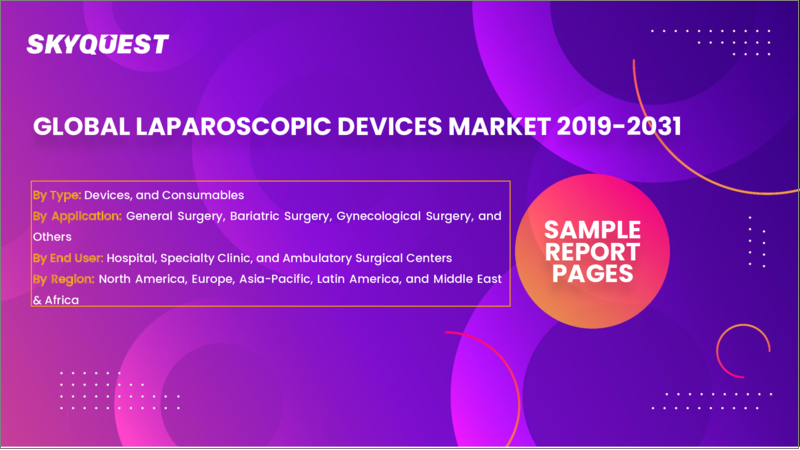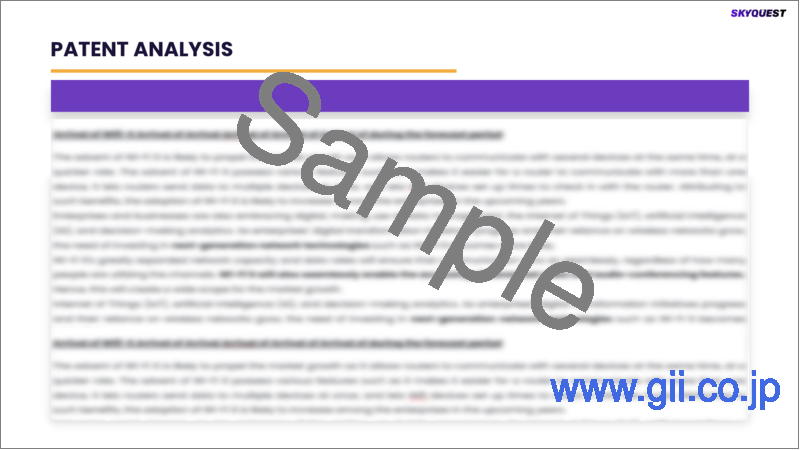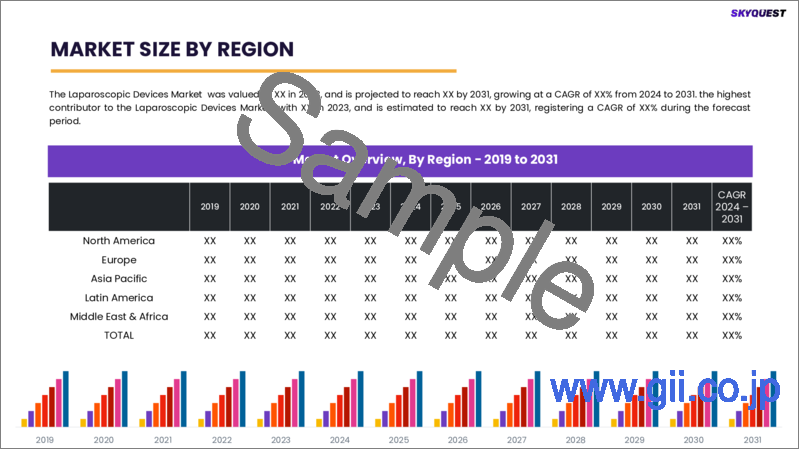|
|
市場調査レポート
商品コード
1396142
腹腔鏡デバイスの世界市場規模、シェア、成長分析、製品タイプ別、用途別、最終用途別- 産業予測、2023-2030年Global Laparoscopic Devices Market Size, Share, Growth Analysis, By Product Type(Laparoscopes, Energy Systems), By Application(Bariatric Surgery, Urological Surgery), By End-use(Hospital, Clinic) - Industry Forecast 2023-2030 |
||||||
| 腹腔鏡デバイスの世界市場規模、シェア、成長分析、製品タイプ別、用途別、最終用途別- 産業予測、2023-2030年 |
|
出版日: 2023年11月22日
発行: SkyQuest
ページ情報: 英文 157 Pages
納期: 3~5営業日
|
- 全表示
- 概要
- 目次
腹腔鏡デバイス市場規模は2021年に67億7,000万米ドルと評価され、2022年の72億7,000万米ドルから2030年には126億米ドルに成長し、予測期間(2023-2030年)のCAGRは7.35%で成長する見通しです。
市場の拡大は、あらゆる年齢層で糖尿病の有病率が増加していること、アジア太平洋地域、特に日本、インド、中国などの国々で高齢者人口が急速に拡大していること、そして迅速な技術進歩に起因しています。世界のヘルスケア部門は、COVID-19の大流行による大きな課題に直面しています。医療サービスへのアクセスが制限されているため、様々な疾病を抱える患者は最適な治療を受けていないです。パンデミックの間、腹腔鏡手術は悪影響を受け、ウイルス感染を減らすために手術が遅れたりキャンセルされたりすることが多いです。大手企業は、地域事業を拡大し、影響を受けた地域に倉庫を増設し、運営チャネルを多様化しようとしています。サプライチェーンの混乱に対処するため、企業は輸送ルートの変更、追加パートナーからの調達、航空貨物配送の利用など、さまざまな戦略を実施しています。パンデミックは地元メーカーにも有利で、市場拡大のための有益な機会を生み出しています。腹腔鏡手術は、在院日数の短縮、出血量の減少、患者の罹患率の低下、回復の早さ、手術結果の成功、感染リスクの低さ、切開創の小ささまたは少なさ、痛みの少なさなど、数多くの利点があるため、従来の方法よりも人気を博しています。腹腔鏡手術の需要増加により、腹腔鏡デバイスの需要増加が見込まれています。子宮筋腫や子宮内膜症などの疾患を持つ患者の急増、子宮摘出術や子宮筋腫摘出術の増加、新興国におけるヘルスケアインフラの改善に対する国民の意識の高まりなどの要因が市場開拓の原動力となっています。
政府の法規制も腹腔鏡デバイスの市場成長を促進する要因の一つです。各国における有利な支払い規制は、それらの地域における腹腔鏡下パワーモルセレーターの収益を押し上げると予測されています。世界の高齢者人口の増加と電気システムの進歩により、その入手可能性と価格が向上し、腹腔鏡デバイスの用途が拡大しています。エネルギーシステムを統合した腹腔鏡デバイスは、胆膵迂回術や十二指腸切替術、可変型胃バンド、胃バイパス術、スリーブ状胃切除術などの肥満手術で有利な用途を見つけることが期待されています。収益の大部分は腹腔鏡デバイス市場から得られており、米国が支配的です。これは、開腹手術よりも腹腔鏡下手術への嗜好が高まっていることと、低侵襲手術の利点に対する認識が高まっていることに起因しています。製品革新に向けた大手企業間の競合も市場に影響を与えると思われます。例えば、オリンパス株式会社は最近、2022年9月に開腹手術用のTHUNDERBEAT Open Fine Jaw Type X手術用電動工具を発表し、処置中の安全性向上を促進し、熱保護機能を追加して日本で市販しています。各社は、さまざまな多様性と戦略的調達に取り組んでいます。例えば、2021年、B. Braun MedicalとKerma Medical Goodsは、退役軍人、有色人種、その他の社会的地位の低い人々へのサービスに焦点を当て、ヘルスケア商品とサービスの創造と提供において協力する意向を発表しました。共同マーケティングの機会、製品開発、環境に配慮した生産、戦略的調達、多様性への取り組みにより、両社の市場開拓が加速することが期待されます。
本レポートの対象セグメント
世界の腹腔鏡デバイス市場は、製品、用途、最終用途、地域に基づいて分類されます。製品別の分類では、市場は腹腔鏡、エネルギーシステム、トロッカー、閉鎖装置、吸引/灌流装置、気腹装置、ロボット支援システム、ハンドアクセス器具に区分されます。用途別では、肥満手術、泌尿器科手術、婦人科手術、一般外科手術、大腸肛門外科手術、その他の手術に区分されます。エンドユーザー別では、市場は病院、クリニック、外来に区分されます。地域別では、世界の腹腔鏡デバイス市場は北米、欧州、アジア太平洋、南米、MEAに区分されます。
促進要因
慢性疾患の負担増
肥満、胃腸障害、婦人科疾患を含む慢性疾患の世界の有病率は増加傾向にあります。腹腔鏡下手術は、その低侵襲性により、これらの疾患の治療にしばしば選択されます。慢性疾患の負担増は、腹腔鏡デバイス市場の拡大に寄与する主要因です。
抑制要因
腹腔鏡デバイスに関連する費用の上昇
腹腔鏡デバイスは、器具、トロッカー、エネルギー機器、画像システムを含み、多額の費用が発生する可能性があります。特に予算に制約のあるヘルスケア施設や発展途上地域の施設にとっては、初期設備投資や継続的なメンテナンス費用が障壁となる可能性があります。腹腔鏡デバイスに関連する高額な費用は、その普及を制限する可能性があります。
市場動向:
ロボット支援腹腔鏡手術の進歩
ロボット支援腹腔鏡手術の採用が増加している背景には、精度、視覚化、器用さを向上させる進歩があります。主要な市場参入企業は、腹腔鏡手術に特化したロボットシステムの開発に向けて投資を行っています。これらのシステムは外科医に高度なコントロールと操作性を提供し、ロボット支援腹腔鏡手術の受け入れ拡大に貢献しています。
腹腔鏡デバイスの小型化
腹腔鏡デバイス市場の顕著な動向は、器具、トロッカー、カメラの小型化が進んでいることです。器具の小型化は切開創の縮小を可能にし、患者の外傷を最小限に抑え、患者の転帰を改善します。材料や製造技術の進歩により、よりコンパクトで軽量な腹腔鏡デバイスの製造が容易になっています。
肥満手術における腹腔鏡の応用の増加
腹腔鏡技術は減量のための肥満手術において重要な役割を果たしています。肥満の有病率の上昇と低侵襲手術への嗜好が、肥満手術における腹腔鏡デバイスの利用拡大に寄与しています。市場開拓では、肥満手術に特化した腹腔鏡デバイスや器具が開発されています。
単切開腹腔鏡手術への需要の高まり
単切開腹腔鏡手術(SILS)の人気の高まりは、1つの小さな切開ですべての手術を実施することで、傷跡を減らし、美容上の結果を改善することにつながります。SILSは、泌尿器科、婦人科、一般外科を含む様々な外科専門分野でますます採用されています。主要な市場関係者は、SILSの需要の高まりに対応するため、特殊な器具やトロカーの開発に注力しています。
目次
- エグゼクティブサマリー
- 調査手法
- 親市場の分析
- 主な市場の考察
- 技術分析
- 価格分析
- サプライチェーン分析
- バリューチェーン分析
- 市場のエコシステム
- IP分析
- 貿易分析
- スタートアップ分析
- 原材料の分析
- イノベーションマトリクス
- パイプライン製品の分析
- マクロ経済指標
- 主な投資の分析
- 主な成功要因
- 競合の程度
- 市場力学と見通し
- 市場力学
- 促進要因
- 機会
- 抑制要因
- 課題
- 規制情勢
- ポーターの分析
- 将来の混乱についての特別な考察
- 市場力学
- 腹腔鏡デバイスの世界市場:製品タイプ別
- 市場概要
- 腹腔鏡
- エネルギーシステム
- トロカール
- 閉鎖装置
- 吸引・灌水装置
- 気腹装置
- ロボット支援システム
- ハンドアクセス器具
- 腹腔鏡デバイスの世界市場:用途別
- 市場概要
- 肥満手術
- 泌尿器科手術
- 婦人科手術
- 一般手術
- 大腸手術
- その他手術
- 腹腔鏡デバイスの世界市場:最終用途別
- 市場概要
- 病院
- 診療所
- 外来
- 腹腔鏡デバイスの世界市場規模:地域別
- 市場概要
- 北米
- 米国
- カナダ
- 欧州
- ドイツ
- スペイン
- フランス
- 英国
- その他欧州地域
- アジア太平洋
- 中国
- インド
- 日本
- 韓国
- その他アジア太平洋地域
- ラテンアメリカ
- ブラジル
- その他ラテンアメリカ地域
- 中東・アフリカ(MEA)
- GCC諸国
- 南アフリカ
- その他中東・アフリカ地域
- 競合情勢
- 上位5社の比較
- 主要企業の市場ポジショニング(2021年)
- 主な市場企業が採用した戦略
- 主要成功戦略
- 市場における最近の活動
- 主要企業の市場シェア(2021年)
- 主要企業プロファイル
- Medtronic PLC
- Johnson & Johnson
- Stryker Corporation
- Karl Storz SE & Co. KG
- Olympus Corporation
- Ethicon, Inc.(A subsidiary of Johnson & Johnson)
- B. Braun Melsungen AG
- Boston Scientific Corporation
- Cook Medical LLC
- Richard Wolf GmbH
- CONMED Corporation
- Smith & Nephew plc
- Applied Medical Resources Corporation
- Intuitive Surgical, Inc.
- Teleflex Incorporated
- Microline Surgical Inc.
- Grena Ltd.
- Lina Medical ApS
- EndoChoice(A part of Boston Scientific Corporation)
- Maxer Endoscopy AG
Laparoscopic Devices Market size was valued at USD 6.77 billion in 2021 and is poised to grow from USD 7.27 billion in 2022 to USD 12.6 billion by 2030, growing at a CAGR of 7.35% in the forecast period (2023-2030).
The market's expansion is attributed to the increasing prevalence of diabetes across all age groups, the rapidly expanding elderly population in the Asia Pacific region, particularly in countries like Japan, India, & China, and swift technological advancements. The global healthcare sector is confronting a significant challenge due to the COVID-19 pandemic. Patients with various diseases have received suboptimal care due to limited access to medical services. Laparoscopy has been adversely affected during the pandemic, with surgeries often delayed or canceled to reduce virus transmission. Major firms are looking to expand their regional operations, establish additional warehouses in affected regions, and diversify their channels of operation. To cope with supply chain disruptions, companies are implementing various strategies, including rerouting transportation, sourcing from additional partners, and utilizing air freight delivery. The pandemic has also favored local manufacturers, creating profitable opportunities for market expansion. Laparoscopic surgery has gained popularity over traditional methods due to its numerous advantages, such as shorter hospital stays, reduced blood loss, lower patient morbidity, quick recovery, successful outcomes, low infection risk, small or no incisions, and less pain. The demand for laparoscopic equipment is expected to rise due to the increased demand for laparoscopic surgery. Market growth is driven by factors such as a surge in patients with conditions like uterine fibroids and endometriosis, increased hysterectomy and myomectomy procedures, and growing public awareness in developing nations about improving healthcare infrastructure.
Supportive government legislation and regulations are another factor promoting market growth for laparoscopic devices. Favorable payment regulations in various countries are projected to boost revenues from laparoscopic power morcellators in those regions. The global increase in the elderly population and advancements in electrical systems, enhancing their availability and affordability, have led to expanded applications for laparoscopic equipment. Laparoscopic devices integrating energy systems are expected to find lucrative applications in bariatric operations like biliopancreatic diversion & duodenal switch, variable gastric band, gastric bypass, or sleeve gastrectomy. The majority of revenue is generated from the laparoscopic device market, with the United States dominating. This is attributed to the growing preference for laparoscopic procedures over open ones and increasing awareness of the benefits of less invasive procedures. Competition among major players for product innovation will also impact the market. For example, Olympus Corporation recently introduced the THUNDERBEAT Open Fine Jaw Type X surgical power tools for open surgery in September 2022, promoting enhanced safety during procedures and commercially available in Japan with additional thermal protection. Companies are working on a variety of diversity and strategic sourcing initiatives. For instance, in 2021, B. Braun Medical and Kerma Medical Goods announced their intention to collaborate in creating and providing healthcare goods and services, with a focus on serving veterans, people of color, and other underrepresented populations. Collaborative marketing opportunities, product development, environmentally friendly production, strategic sourcing, and diversity initiatives are expected to accelerate market growth for both companies.
Segments covered in this report
The global laparoscopic devices market is categorized on the basis of product, application, end-use, and region. With respect to categorization by product, the market is segmented into laparoscopes, energy systems, trocars, closure devices, suction/ irrigation device, insufflation device, robot assisted systems, and hand access instruments. Based on application, the market is segmented into bariatric surgery, urological surgery, gynecological surgery, general surgery, colorectal surgery, and other surgeries. Based on end-user, the market is segmented into Hospital, Clinic, Ambulatory. Based on region, the global Laparoscopic Devices Market is segmented into North America, Europe, Asia-Pacific, South America, and MEA.
Drivers:
Increasing Burden of Chronic Conditions
The global prevalence of chronic diseases, including obesity, gastrointestinal disorders, and gynecological conditions, is on the rise. Laparoscopic procedures are often the preferred choice for treating these conditions due to their minimally invasive nature. The growing burden of chronic diseases is a key factor contributing to the expansion of the laparoscopic devices market.
Restraints:
Elevated Expenses Associated with Laparoscopic Devices
Laparoscopic devices, encompassing instruments, trocars, energy devices, and imaging systems, can incur substantial costs. The initial capital investment and ongoing maintenance expenses may pose a barrier, particularly for healthcare facilities with constrained budgets or those situated in developing regions. The high expenses related to laparoscopic devices have the potential to limit their adoption.
Market Trends:
Advancements in Robotic-Assisted Laparoscopic Surgery
The increasing adoption of robotic-assisted laparoscopic surgery is driven by advancements that enhance precision, visualization, and dexterity. Major market players are directing investments towards the development of robotic systems tailored specifically for laparoscopic procedures. These systems provide surgeons with heightened control and maneuverability, contributing to the growing acceptance of robotic-assisted laparoscopic surgery.
Miniaturization of Laparoscopic Devices
A notable trend in the laparoscopic devices market is the ongoing miniaturization of instruments, trocars, and cameras. The shift towards smaller devices allows for reduced incision sizes, minimizing patient trauma and improving overall patient outcomes. Progress in materials and manufacturing techniques facilitates the creation of more compact and lightweight laparoscopic devices.
Increasing Application of Laparoscopy in Bariatric Surgery
Laparoscopic techniques play a crucial role in bariatric surgery for weight loss. The escalating prevalence of obesity and the preference for minimally invasive procedures contribute to the growing utilization of laparoscopic devices in bariatric surgery. The market is witnessing the development of specialized laparoscopic instruments and devices tailored for use in bariatric procedures.
Growing Demand for Single-Incision Laparoscopic Surgery
The rise in popularity of single-incision laparoscopic surgery (SILS) involves conducting entire procedures through a single small incision, leading to reduced scarring and improved cosmetic outcomes. SILS is increasingly adopted across various surgical specialties, including urology, gynecology, and general surgery. Major market players are concentrating on creating specialized instruments and trocars to meet the rising demand for SILS.
Table of Contents
- Executive Summary
- Market Overview
- Wheel of Fortune
- Research Methodology
- Information Procurement
- Secondary & Primary Data Sources
- Market Size Estimation
- Market Assumptions & Limitations
- Parent Market Analysis
- Market Overview
- Market Size
- Market Dynamics
- Drivers
- Opportunities
- Restraints
- Challenges
- Key Market Insights
- Technology Analysis
- Pricing Analysis
- Supply Chain Analysis
- Value Chain Analysis
- Ecosystem of the Market
- IP Analysis
- Trade Analysis
- Startup Analysis
- Raw Material Analysis
- Innovation Matrix
- Pipeline Product Analysis
- Macroeconomic Indicators
- Top Investment Analysis
- Key Success Factor
- Degree of Competition
- Market Dynamics & Outlook
- Market Dynamics
- Drivers
- Opportunities
- Restraints
- Challenges
- Regulatory Landscape
- Porters Analysis
- Competitive rivalry
- Threat of Substitute Products
- Bargaining Power of Buyers
- Threat of New Entrants
- Bargaining Power of Suppliers
- Skyquest Special Insights on Future Disruptions
- Political Impact
- Economic Impact
- Social Impact
- Technical Impact
- Environmental Impact
- Legal Impact
- Market Dynamics
- Global Laparoscopic Devices Market by Product Type
- Market Overview
- Laparoscopes
- Energy Systems
- Trocars
- Closure Devices
- Suction/ Irrigation Device
- Insufflation Device
- Robot Assisted Systems
- and Hand Access Instruments
- Global Laparoscopic Devices Market by Application
- Market Overview
- Bariatric Surgery
- Urological Surgery
- Gynecological Surgery
- General Surgery
- Colorectal Surgery
- and Other Surgeries
- Global Laparoscopic Devices Market by End-use
- Market Overview
- Hospital
- Clinic
- and Ambulatory
- Global Laparoscopic Devices Market Size by Region
- Market Overview
- North America
- USA
- Canada
- Europe
- Germany
- Spain
- France
- UK
- Rest of Europe
- Asia Pacific
- China
- India
- Japan
- South Korea
- Rest of Asia-Pacific
- Latin America
- Brazil
- Rest of Latin America
- Middle East & Africa (MEA)
- GCC Countries
- South Africa
- Rest of MEA
- Competitive Landscape
- Top 5 Player Comparison
- Market Positioning of Key Players, 2021
- Strategies Adopted by Key Market Players
- Top Winning Strategies
- By Development
- By Company
- By Year
- Recent Activities in the Market
- Key Companies Market Share (%), 2021
- Key Company Profiles
- Medtronic PLC
- Company Overview
- Business Segment Overview
- Financial Updates
- Key Developments
- Johnson & Johnson
- Company Overview
- Business Segment Overview
- Financial Updates
- Key Developments
- Stryker Corporation
- Company Overview
- Business Segment Overview
- Financial Updates
- Key Developments
- Karl Storz SE & Co. KG
- Company Overview
- Business Segment Overview
- Financial Updates
- Key Developments
- Olympus Corporation
- Company Overview
- Business Segment Overview
- Financial Updates
- Key Developments
- Ethicon, Inc. (A subsidiary of Johnson & Johnson)
- Company Overview
- Business Segment Overview
- Financial Updates
- Key Developments
- B. Braun Melsungen AG
- Company Overview
- Business Segment Overview
- Financial Updates
- Key Developments
- Boston Scientific Corporation
- Company Overview
- Business Segment Overview
- Financial Updates
- Key Developments
- Cook Medical LLC
- Company Overview
- Business Segment Overview
- Financial Updates
- Key Developments
- Richard Wolf GmbH
- Company Overview
- Business Segment Overview
- Financial Updates
- Key Developments
- CONMED Corporation
- Company Overview
- Business Segment Overview
- Financial Updates
- Key Developments
- Smith & Nephew plc
- Company Overview
- Business Segment Overview
- Financial Updates
- Key Developments
- Applied Medical Resources Corporation
- Company Overview
- Business Segment Overview
- Financial Updates
- Key Developments
- Intuitive Surgical, Inc.
- Company Overview
- Business Segment Overview
- Financial Updates
- Key Developments
- Teleflex Incorporated
- Company Overview
- Business Segment Overview
- Financial Updates
- Key Developments
- Microline Surgical Inc.
- Company Overview
- Business Segment Overview
- Financial Updates
- Key Developments
- Grena Ltd.
- Company Overview
- Business Segment Overview
- Financial Updates
- Key Developments
- Lina Medical ApS
- Company Overview
- Business Segment Overview
- Financial Updates
- Key Developments
- EndoChoice (A part of Boston Scientific Corporation)
- Company Overview
- Business Segment Overview
- Financial Updates
- Key Developments
- Maxer Endoscopy AG
- Company Overview
- Business Segment Overview
- Financial Updates
- Key Developments
- Medtronic PLC




